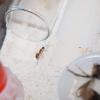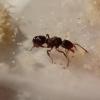I'm thinking this might be Lasius Claviger.
1. Location (on a map) of collection: Salina Kansas
2. Date of collection: 11/16/18
3. Habitat of collection: Roots of silphium (related to sunflower), there was a colony of crematogaster cersei in the same root, but they were in separate locations. the crematogasters did not recognize her as a member.
4. Length (from head to gaster): 7 mm or 0.28 inches (Edited)
5. Color, hue, pattern and texture: body is amber, the legs are a bit lighter.
6. Distinguishing characteristics: one sharp/pointy petiole nodes, no spines that i could see. antennea from what i can tell have 12 segments.
7. Distinguishing behavior: when confronted with a crematogaster worker she just ran away, did not attempt to fight.
8. Nest description: Unknown.
9. Nuptial flight time and date: Unknown
Pics:
Edited by Nanos, November 21 2018 - 12:19 AM.




















